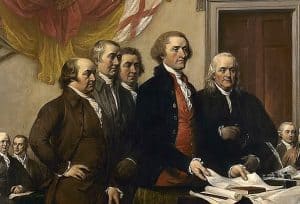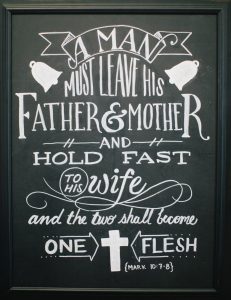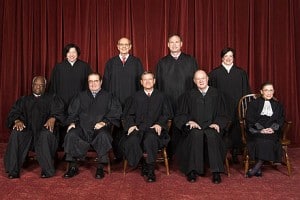The Real Reason Society Is Unraveling, Part 3
There are three things that are too amazing for me,
four that I do not understand:
the way of an eagle in the sky,
the way of a snake on a rock,
the way of a ship on the high seas,
and the way of a man with a young woman.
—Proverbs 30:18-19 (NIV)—
The history of the human race began with a wedding.
—Herman Bavinck—
Key points: The state doesn’t own or have ultimate authority over marriage; God does. It is the state’s duty to recognize marriage as what it is and to respect and protect it. In its ruling in Obergefell, the Supreme Court instead sought to pull marriage out from under God’s authority. The Founders of America never would have allowed this to happen. We who understand what marriage is must reclaim it and remind government of its God-given duty concerning marriage.
You can access all the articles in this series from this page.
This post is available as a stand-alone article here.
Last time, in part 2, we cited this CrossPolitic video in which David Fowler, Executive Director of the Family Action Council of Tennessee, explained the importance of the Ninth Amendment, common law, and the laws of God that stand behind both of these. Divine laws also stand behind America’s other founding documents, including the Declaration of Independence and the Bill of Rights. It is no coincidence, for example, that in the Declaration, the Founders wrote of “the Laws of Nature and of Nature’s God.” Against this backdrop, they further wrote about the purpose of government. They said,
We hold these truths to be self-evident, that all men are created equal, that they are endowed by their Creator with certain unalienable Rights, that among these are Life, Liberty and the pursuit of Happiness. — That to secure these rights, Governments are instituted among Men, deriving their just powers from the consent of the governed, — That whenever any Form of Government becomes destructive of these ends, it is the Right of the People to alter or to abolish it, and to institute new Government, laying its foundation on such principles and organizing its powers in such form, as to them shall seem most likely to effect their Safety and Happiness.
Why were the Founders dissolving the bond between the Colonies and Great Britain? Because the Mother Country was, and had been for some time, overstepping its authority; the government had become “destructive of these ends” — the ends, or the purposes the Founders named for which “Governments are instituted among Men.” Great Britain wasn’t protecting God-given rights! Further, it no longer was “deriving…just powers from the consent of the governed.”
The Purpose of Government

We cannot fully understand the US Constitution, nor can we understand the Bill of Rights, unless we comprehend the purpose of government as described in the Declaration of Independence. The Constitution set up a limited government specifically to “secure” or protect the “unalienable,” God-given rights of citizens. What were and are some of these rights? The Declaration mentions “Life, Liberty and the pursuit of Happiness” as being “among” the rights governments are established to protect. The Constitution, and especially the Bill of Rights, mention additional ones.
We cannot fully understand the US Constitution, nor can we understand the Bill of Rights, unless we comprehend the purpose of government as described in the Declaration of Independence.
In the Bill of Rights, the first eight amendments highlight numerous specific rights — but James Madison and the other Founders who crafted the Bill of Rights were careful to stipulate in the Ninth and Tenth Amendments that the first eight amendments did not enumerate exhaustive lists of rights or powers. Could the unenumerated rights — the rights not listed — involve just anything, or did they have a source? The source of rights already had been specified in the Declaration: All people “are created equal,…[and] are endowed by their Creator with certain unalienable Rights” (emphasis added).
The state has a duty to recognize this, said the Founders in the Declaration. “[T]o secure these rights, Governments are instituted among Men, deriving their just powers from the consent of the governed” (emphasis added). The Declaration, of course, was adopted in 1776. The Constitution was drafted in 1787, and a little less than a year later, on Saturday, June 21, 1788, “New Hampshire became the critical ninth state to ratify the Constitution. That day, the Constitution was officially adopted, and the new government officially started operating on March 4, 1789.”
The purpose of government is to recognize and protect the unalienable, God-given rights of its people.
At this point, however, the Constitution did not include a bill of rights. It would not until December 15, 1791. Watch this informative video to learn how the Bill of Rights became a part of the US Constitution, as well as why such a document was necessary. (Also, check out this important series of videos on the Bill of Rights from the Pacific Legal Foundation.)
In this video, this statement is critically important:
Some feared that creating an explicit list of things that the government can’t do would imply that it can do everything else.
The architects of the Bill of Rights addressed this important concern in the Ninth and Tenth Amendments.
The Ninth Amendment: Unalienable Rights Not Named Still Exist and Must Be Respected
As we stated at the top of this post, last time we heard from David Fowler, who was a guest for this CrossPolitic interview. Mr Fowler explained that behind both the Ninth Amendment and the common law on which it relies (more on that momentarily), we find God’s law as presented in Scripture. The Ninth Amendment states,
The enumeration in the Constitution of certain rights shall not be construed to deny or disparage others retained by the people.
It was impossible for the Bill of Rights to explicitly name every right the people enjoyed and that the the government had a duty to protect. The Ninth Amendment, therefore, upheld the rights that had not been named, and it and stated these also were to be protected and honored. If they were unnamed, however, how could anyone know what these rights were? It was understood and accepted that one would go to the common law, or case law, to learn what these rights were. Again, common law or case law was based on an objective, unchanging standard of ethics and morality — divine directives revealed in the Bible.
Common Law and Case Law
At this point, a word of explanation about case law is in order. Because laws must be applied to numerous situations that vary in terms of their specific details, no slate of laws can cover every possible aspect of what happens. In the interview, Mr. Fowler offers an example similar to this: A gentleman sits down at a table at a restaurant and orders a bowl of soup and a glass of water. Instead of what the man had ordered, however, the server brings a steak dinner. Aghast, the man says, “Well, that’s not what I ordered!” and leaves. Angry, the owner of the restaurant sues the customer for not paying for the steak dinner. How should a judge rule in such a case? Clearly, he should rule for the defendant.

Mr. Fowler goes on to offer a second scenario. Another man enters the restaurant and orders soup and water; and again, the server brings an elaborate dinner, including a steak and other expensive food items. This patron also leaves the restaurant and refuses to pay, but only after eating the meal. The restaurant sues the man for not paying for his meal. Like the first customer we described, he defends himself by saying, “But I didn’t order a steak at all! I ordered soup and water.” How should the judge rule in this case?
The difference is that the second customer ate the meal, despite the fact he hadn’t ordered the items he was brought. Can he justly claim he isn’t obligated to pay for the steak dinner because he didn’t order it? In such a case, a judge certainly would rule fairly if he or she issued an opinion in favor of the plaintiff.

Behind both of these scenarios is application of God’s law as stated in the Eighth Commandment — “You shall not steal.” Yet the rulings were different because the differences between the situations called for different rulings: Theft took place in the second situation, but not in the first. Over time, as the number of rulings in the various cases that arose grew, a body of legal precedents shaped and formed what became known as “common law.” It’s essential for us to understand that, just as Mr. Fowler stated, behind the common law was God’s law.
Now, this portion of what Mr. Fowler said last time in this clip should make even more sense.
And so should this portion —
Note these insights from these two clips.
-
-
- First, a judge’s opinion was considered to be, not what the law said, but what he thought the law said. Thus, among other things, there was an understanding that the judge was under the law and not infallible. This idea itself was revolutionary. Samuel Rutherford (1600-1661) of Scotland lived many years prior to the founding of America but still was influential in its founding. He wrote a book in which he argued that public authorities, namely kings, do not have absolute authority. The book was titled Lex Rex — Law Is King. This refuted the previously held notion of lex rex, the king is law.
- Second, case law became common law, not by standing on its own, but by resting on God’s law, which was and is foundational. In other words, case law became common law because it was considered to be a complication of judgments that were deemed to represent the best applications of God’s laws in various situations, or of civil laws that also rested on and were entirely consistent with divine laws.
-
Oh, how we need this kind of awareness and humility among the judiciary (and in other branches of government as well) today!
What Is Marriage, and Who Defines It?
Marriage, of course, predates government and predates all manmade laws. Mr. Fowler discusses marriage during the remainder of the video. He explains that marriage statues requiring marriage licensing and marriage certificates were formulated by states for convenience, to make it possible to readily verify that weddings had indeed occurred, that couples were (or that a particular couple was) indeed married and not simply living together.

In the early days of this country, families often lived in one location for generations. Everyone in the area knew who everyone else was, as well as how people they knew were related. All that changed as the nation’s population grew and America moved toward being primarily an industrial society rather than an agricultural one. States began to require marriage certificates, but did they create marriage? Did they define it? No, they rather recognized the centuries-old definition of marriage and fashioned a means of proof that weddings, or a wedding, actually had occurred. Therefore, the establishment of marriage statues was consistent with the common law and its recognition of marriage as a one-man, one-woman institution.
 All that went out the window with the Obergefell ruling. The Supreme Court in Obergefell acted as though the state had created marriage and had the right to manipulate it at will.
All that went out the window with the Obergefell ruling. The Supreme Court in Obergefell acted as though the state had created marriage and had the right to manipulate it at will.
In a moment, you’ll have the opportunity to listen to Mr. Fowler on this aspect of the situation and to hear the discussion that took place among the members of the CrossPolitic gang. In the clip you will hear, David mentions positive law. What is that? It is a law that authorizes a “right,” service, or resource that would not otherwise exist. We would call the resulting “right” a “positive right.” Negative rights, by contrast, are “unalienable” and God-given; they already exist and can be enjoyed as long as governments and other people stay out of one’s way. As we said at the beginning of this article, America’s Founders believed it was and is the role of the state to recognize unalienable (or negative) rights and protect them. In doing so, government paves the way for ordered liberty. We have discussed this extensively at Word Foundations in both our series on rights. Here is the essence of what you need to know at this point:
Negative rights are the rights we enjoy because government is restricted from forbidding or hindering personal activity. Positive rights are “rights” that are secured when government intervenes in citizens’ lives to give them resources or to otherwise enable them to do or to have certain things. Generally speaking, America’s Founders and early leaders enthusiastically upheld the former and rarely upheld the latter (the right to a trial by jury being one such instance). Accordingly, the Founders drafted and ratified the Bill of Rights to the US Constitution, which secured foundational rights of citizens through government limitations.
No decision in the history of the Supreme Court of the United States violates the principles of freedom and liberty upheld by America’s Founders as does the ruling in Obergefell v. Hodges. Same-sex “marriage” isn’t just about the private affairs of those who petitioned the Court to establish it. It is about everything else, as well. Obergefell v. Hodges is moving this country from liberty to tyranny as is nothing else. To counter, we must rediscover natural marriage as God-given and unalienable, and we must uphold it as such.
No decision in the history of the Supreme Court of the United States violates the principles of freedom and liberty upheld by America’s Founders as does the ruling in Obergefell v. Hodges, although the decisions in Roe v. Wade and Doe v. Bolton run a close second.
Now, hear Mr. Fowler and the interaction that took place among Mr. Fowler and the members of the CrossPolitic panel. This clip is just over a minute-and-a-half long.
Note carefully — the Supreme Court played god when it crafted and issued its decision in Obergefell. The Supreme Court has essentially written its own version of Rex Lex and in doing so has said “The Court Is Law” — but it is not.
The Way Back
How can authentic liberty in America and the principles on which it rests be rediscovered and upheld once again? Next time we will explore a possible legal pathway, one that involves the Ninth Amendment, Marriage, and a proposed law that would once again allow people to recognize marriage in the state of Tennessee as being what it truly is — a one-man, one-woman institution.

Don’t miss our discussion next time, but also try to educate others about the principles and ideas already presented in this series of articles. That’s the other essential ingredient to preserving liberty in this nation: People need to understand
-
-
-
- where we were,
- why we were at a much better place,
- how we started drifting, and
- the critical need for us to come back.
-
-
Everyone has a sphere of influence in which he or she can operate, enlightening others and even changing their minds.
Will you do your part?
Copyright © 2022 by B. Nathaniel Sullivan. All rights reserved.
Unless otherwise indicated, Scripture has been taken from the New King James Version®. Copyright © 1982 by Thomas Nelson, Inc. Used by permission. All rights reserved.
One Scripture passage, cited at the top of this article, has been marked NIV and is taken from The Holy Bible, New International Version®, NIV® Copyright © 1973, 1978, 1984, 2011 by Biblica, Inc.® Used by permission. All rights reserved worldwide.
top image credit: Photo by Ryan Franco on Unsplash
CrossPolitic video featuring David Fowler:

Be First to Comment